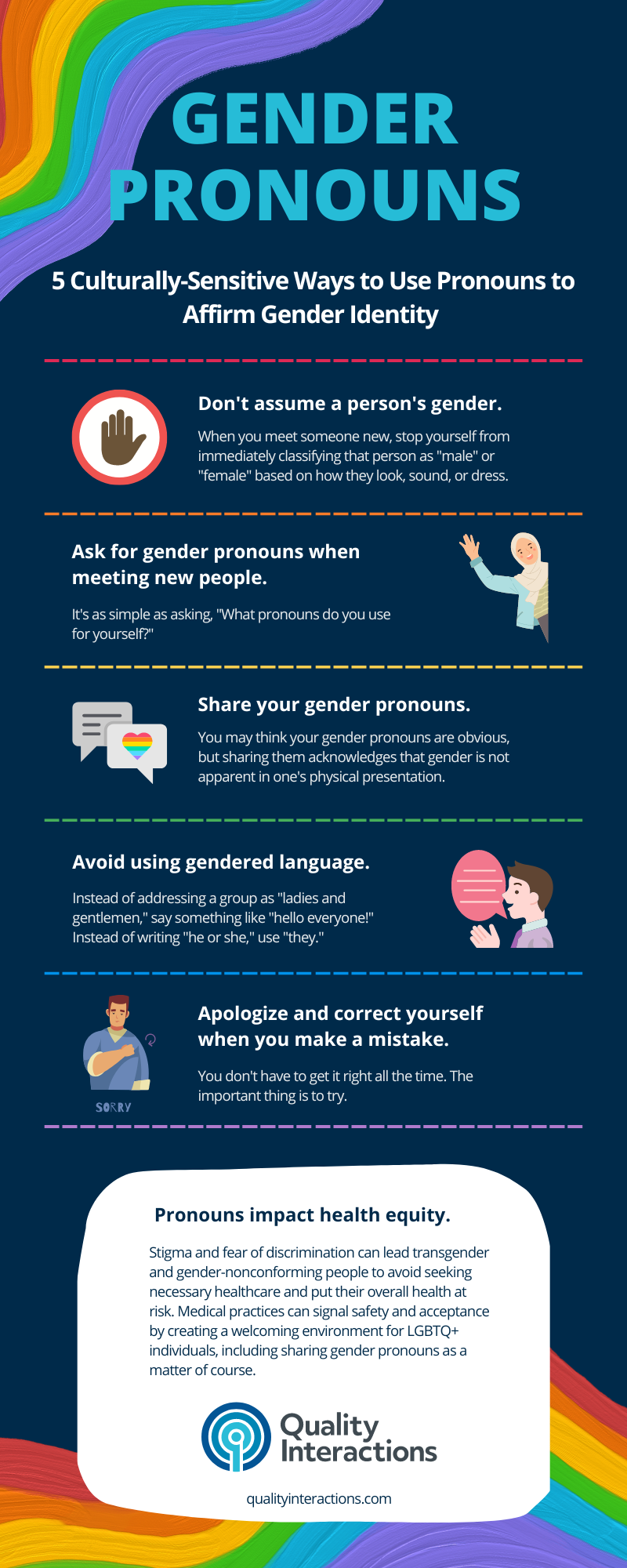
Pronouns are a standard part of speech and written communication. They provide a shorthand way to refer to a proper noun—a person, place, or thing—without excessive repetition. Common pronouns include: she, he, we, and it.
In English and many other languages, pronouns often imply gender. For example, "he" refers to men and boys, while "she" is used for women and girls. As our understanding of gender has evolved to recognize a spectrum of gender identities, it's become clear that these associations aren't always accurate or appropriate.
In a non-binary world, gender is a nuanced and fluid social concept that one can't assume based on a person's name or appearance. A person may identify with genders not assigned at birth, with multiple genders, or with no gender. Their identity may include transgender, non-binary, or gender-neutral. And their identity may shift and change over time.
Gender-Neutral Pronouns
People who don't identify with a gender binary often choose to use non-gendered pronouns. The most common example is the singular use of "they/them/theirs" in place of "he/him/his" or "she/her/hers." Other gender-neutral pronouns include "ze" and "hir."
Research indicates that misgendering or refusing to accept a person's gender identity causes feelings of stigmatization and low self-esteem. Conversely, knowing and using a person's chosen gender pronouns demonstrates acceptance and respect and cultivates an inclusive environment.
Gender Pronouns and Health Equity
Transgender and gender-nonconforming people experience more chronic health conditions and incidences of HIV, substance abuse, mental illness, and sexual violence than the general population. They also encounter more impediments to quality healthcare, including lack of insurance coverage and discriminatory barriers.
Stigma and fear of discrimination can lead transgender people to avoid seeking necessary healthcare and put their overall health at risk. Hospitals, clinics, and medical practices can signal safety and acceptance by creating a welcoming environment for LGBTQ+ individuals, including respecting people's gender pronouns and sharing pronouns as a matter of course.
Affirming Gender Identity with Pronouns
To practice culturally-sensitive communication, people and organizations need to support the use of self-identified pronouns and self-identified names that might differ from legal ones. Here are some tips to help understand and affirm someone's gender identity.
- Don't assume a person's gender.
When you meet someone new, stop yourself from immediately classifying that person as "male" or "female" based on how they look, sound, or dress. These assumptions arise from implicit bias, or stereotypical thinking, that comes from cognitive shortcuts the brain makes to process information quickly. Taking the time to stop and recognize biases is the first step to overcoming biased reactions and decision-making. - Ask for gender pronouns when meeting new people.
Instead of assuming, ask people what pronouns they use. For example, "What pronouns do you use for yourself?" You may feel awkward at first, but with practice, this will become a routine "getting to know you" question. - Share your gender pronouns—and standardize this practice in organizations.
Sharing your gender pronouns is an easy and effective way to create a shared space that is inclusive and affirming. You may think your gender pronouns are obvious, but sharing them acknowledges that gender is not apparent in one's physical presentation. Try introducing yourself by saying something like, "Hi, I'm Dr. Smith. I use the pronouns 'she' and 'her.' What about you?" On an organizational level, add gender pronouns to email signatures, team profiles, and intake forms. - Avoid using gendered language.
Organizations should use non-gendered language in written and oral communication and provide gender-neutral facilities (such as bathrooms). Instead of addressing a group as "ladies and gentlemen," say something like "hello everyone!" Instead of writing "he or she," use "they." - Apologize and correct yourself when you make a mistake.
If you accidentally use the wrong pronoun, apologize and correct yourself. For example, "Sorry, I meant to say they." You don't have to get it right all the time. The important thing is to try.
Diversity is Good for Everyone
Affirming gender identities encourages more diversity in your organization and personal relationships. And more diversity is good for everyone. Studies show that being around people who are different from us enhances creativity, improves decision-making and problem-solving, and stimulates innovation. Focusing on cultural competency and creating a welcoming environment for LGBTQ+ individuals will help you build communication skills, strengthen connections, and garner benefits throughout your life.



